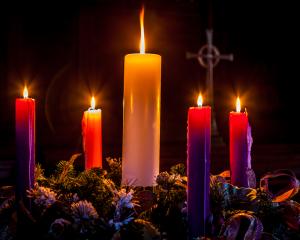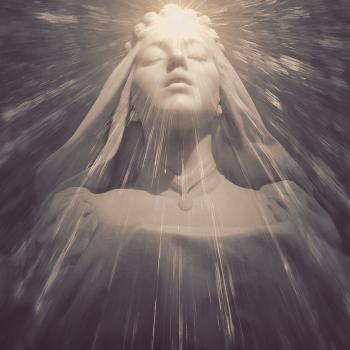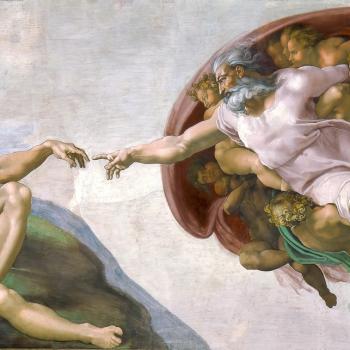 For many of us, Advent is the best season. It marks the beginning of the next ecclesiastical year and prepares us to celebrate the birth of Christ at Christmas. The Catholic liturgical calendar describes Advent in these words: “While remembering His first coming, we also look forward to the return of our Savior when He will return to judge the living and the dead.”
For many of us, Advent is the best season. It marks the beginning of the next ecclesiastical year and prepares us to celebrate the birth of Christ at Christmas. The Catholic liturgical calendar describes Advent in these words: “While remembering His first coming, we also look forward to the return of our Savior when He will return to judge the living and the dead.”
But this description puzzles me. Isn’t Jesus present in our hearts at all times, through prayer and especially during the Consecration?
A Distinction between Religion and Spirituality
Briefly, most religions are institutions with a formal set of beliefs, rituals, and rules. In the Catholic Church, this structure evolved over hundreds of years. We trace our history to Jesus and the apostles, but the elaborate organization of the basic Catholic doctrine was not established until the 4th and 5th centuries. The Council of Nicea in 325 affirmed the co-divinity of the Son; the Holy Spirit was added in 381 to complete the Trinity. Priestly celibacy was established in the 12th century. The nature of the presence of Christ in the Eucharist was not defined until the 13th c. And not until 1870 were popes declared to be infallible.
Although the Second Vatican Council ending in1965 reappraised some rules, today’s Catholic Church is now facing what many recognize as its most serious crisis in the 500 years since the Protestant Reformation. Much of the current division within the church relates to its teachings on sexuality and the role of women. No doubt some changes will be made; that is how our church has survived over time and endured. At 1.1 billion members, it is greater than all other Christian religions combined.
Our beliefs and practices unite us into one single moral community that has many benefits. Catholic churches around the world say the same Mass in a multitude of languages. We learn the same prayers as children, and we talk to God in similar ways––thanking Him and praising His glory, but more often begging God to hear our prayers, to answer us and grant our requests. We beseech. We talk to a listening God and tell Him our sorrows and our troubles. We await answers from God ––-and wish that they were out loud and in English.
Has our religion given us the impression that we are here on earth sending up our petitions to the Father, to Jesus, to Mary, or to any of the saints we believe might intercede for us, prayers that sometimes are said by rote or habit? And that, for me, is one of the greatest differences between religion and spirituality. Religion is often dualistic, meaning two parts––we on earth are separate from the Godhead in heaven, a dual hierarchy of Creator and created.
Spirituality, however, is non-dualistic, meaning that God is not distant but is present right now within us. . As Jesus said, in John, 14:20,
On that day you will realize that I am in my Father, and you are in me, and I am in you.
Spirituality is the individual’s own personal discovery of the greater Power within that gives meaning and inspiration, the One who includes all three persons of the divine as well as the sense of individual self.
We need both the structure of religion and the inner wisdom of spirituality. But how can we combine these two parts of spiritual life to enrich our awareness and realize God’s presence within us at all times?
Wisdom from Many Sources
Fortunately we have had teachers sharing that answer throughout history: the Christian life is not only a matter of behaving like Christ, but of allowing Christ himself to live in and through us.
The apostle Paul in Galatians 2:20, said,
it is Christ who lives in me.—
And in 2 Corinthians 13:5, Paul asks the Corinthian believers a question,
Or do you not realize about yourselves that Jesus Christ is in you?
In saying, “Jesus Christ is in you,” Paul wasn’t speaking poetically or metaphorically. He truly meant that Jesus Christ is literally dwelling within the believers. We, too, like the Corinthians, need to realize this fact about ourselves. Christ is not merely outside of us, a Helper in our time of need, but He dwells in us, living in and with us at all times.
Julian of Norwich was an important English Christian mystic and theologian. Her Revelations of Divine Love, written around 1395, is the first known book in the English language by a woman and is widely acknowledged as one of the great classics of the spiritual life. She wrote,
It is easier for us to get to know God than to know our own soul…
God is nearer to us than our soul, for He is the ground in which it stands…
Many others confirm that the Lord actually dwells within us. But spiritual writing has never been limited to apostles, to female mystics, nor even to Catholics.
Alfred Lord Tennyson, 1809-1892, the Poet Laureate of Great Britain and Ireland, wrote,
Speak to Him, thou, for He hears, and Spirit with Spirit can meet-
Closer is He than breathing, and nearer than hands and feet.
When William Blake wrote,
To see a World in a Grain of Sand
And a Heaven in a Wild Flower,
Hold Infinity in the palm of your hand
And Eternity in an hour.
Blake anticipated the interrelated oneness of the universe that astronomer Carl Sagan stated in 1973; after concluding that all the chemical elements that make up life were released by stellar explosions billions of years ago, Sagan said,
We are made of star-stuff.
And in The Unbound Soul, the writer Richard Haight declared,
All that is, is within you. And you are within it; there is no other.
In other words, God is Transcendent, present throughout creation and within us.
The late Wayne Dyer wrote,
. . . there is a universal God force that is in all things in the universe. . .
. . . the same God force that is within you and causes you to think and breathe is simultaneously in everyone and everything else as well.
It is universal. Thus, there is no place that it is not.
When one enlightened sage lay dying, his followers surrounded him tearfully crying repeatedly, “Don’t leave us, Master.” He answered them,
Don’t be silly. Where would I go?
How God Makes His Presence Known
How is it that God makes His presence known to these contemplative writers? They listen. As Mother Teresa observed,
It is in the silence of the heart that God speaks.
We do not have to pray that God will come to us. We have to wake up and become mindful to the fact that He already is within us, present in all that we do.
Now the question becomes, how do we wake up? Direct experience is their key to spiritual wisdom. By setting an intention for what we desire, by paying attention, and by making efforts we will find our own discoveries. And dis-covery is really uncovering what has been there all along.
Meditation is one spiritual exercise of going deep within to develop mindfulness, but it becomes sterile if it is only practicing unfamiliar techniques. Fortunately, we also have what is called Centering Prayer to help us open our whole mind and heart to God, beyond thoughts, words, and emotions. It is a way to “Be still and know that I am God,” (Psalm 46:10).
The Centering Prayer
By centering, we contact the Being Who fills us with the Presence of light and love. As we listen for direction and guidance, each one of us can begin to recognize we are one with that Being.
You may already know the four simple guidelines for Centering Prayer:
- Choose a sacred word, or a word like love or peace, as your intention to consent to God’s presence and action within.
- Sit comfortably, with gaze uplifted and eyes closed, and silently introduce that word as the symbol of centering your awareness on God.
- Whenever your own inevitable thoughts engage you, return gently to the sacred word or pay attention to your breathing. “Where attention goes, energy flows.”
- At the end of the 20-minute prayer period, remain in silence with your eyes closed for a few minutes.
During that short prayer period not much will happen right away. God doesn’t exactly come and tap us on the shoulder. But the more often we practice, the more we become open to signs from God, even in everyday experiences. When the mind is receptive and ready, we can receive messages in many different ways. Some may come in the form of synchronicity, small coincidences that occur more frequently. Sometimes dreams provide a signal. Even certain problems may signify a spiritual wake-up call to turn to God.
Music
Music is another way in which we can hear God speaking to us. I often listen to a CD titled Calling All Angels when I‘m taking a walk. In one of the verses, there is this message,
Do you hear Me calling you? I whisper through doorways down the passage of your mind, clear as the morning dew. . .
Nature
Do you not also feel the joy of God’s presence when you are out in the beauty of nature? The Jesuit Pierre Teilhard de Chardin said,
Joy is the most infallible sign of the presence of God.
And Christmas is a time for joy. Christmas is the birth of love in one’s own heart, a love as trusting and guileless as a newborn babe. The miracle is not only putting selfishness aside to make room for this love, but continuing to nurture and protect it so that love may grow, yet still remain as fresh and innocent as in its beginning. This is our personal Advent, when God is truly born within our hearts.












